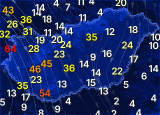WIND POWER
WIND POWER
 Wind power
Wind power WIND POWER
The use of wind power provides people the opportunity to partially or wholly generate the electricity, fuel or water used in their homes. Distancing ourselves from fossil fuels is particularly important, in part to bring global warming to its assumed halt and to reduce the emission of harmful substances and also because of the threats of the approaching peak oil.
The use of wind power is one of the fastest
growing forms of exploiting renewable energy
sources with the highest capacity
increase in recent years. Wind power
generation currently increases by 20% annually.
Using wind power, the VertiGo SRG Wind
Generator product line is a committed and
consistent embodimentof the sustainable and
viable development model.

 History
History HISTORY
The kinetic energy of wind has been used for thousands of years - with
the help of sails, for example - but its use in architecture to
operate various ventilation systems looks back on a similarly
long history. The first wind-driven machine was a wind wheel by
Hero of Alexandria in the 1st century.
The wind mills, known since the Middle Ages, used wind power. These
appeared on the territory of today’s Iran in the 9th century, although
some theories suggest that they had already been in use as early as
the 7th century. From then on, these structures came into increasingly
general use in the Middle East and Central Asia. They were employed
in India and China as well, when around 1180 they began to appear
in a number of places in Northwestern Europe mainly to mill grain
but also to drain land making it suitable for cultivation or
construction.


This technology was brought to the American
continent by European settlers.
At the end of the 19th century, people started using wind power for pumping
water. In the 1920s, similar technologies were used in rural areas of
the United States, but these became outdated with the growth of the
electricity grid, and wind power only began to play a more significant
role at the end of the 20th century. At the beginning of the 21st
century, thanks to technological advance, the cost of investing in
wind power decreased rapidly and at present it is one of the fastest
growing sources of energy with an annual capacity growth around 20%.
Interesting fact: In 2012, a toy inspired Massoud Hassani of
Afghanistan to develop a wind-driven device to activate land mines.
At the time of the Austro-Hungarian compromise of 1867, there were
more than 1,000 wind mills in operation in Hungary on the
territory of today’s Csongrád County.

 The energy of the wind
The energy of the wind THE ENERGY OF THE WIND
1-3% of the Sun’s energy reaching the Earth is transformed into wind power. This is 50-100 times
more than what the entire flora of the Earth converts through photosynthesis.
A large part of this wind power is found at high altitudes where continuous wind speeds
can exceed 160 kilometres per hour. Through the friction the wind power is dissipated in
the Earth's atmosphere and on its surface.
Wind is generated because the Earth’s rotation causes the Sun’s heat to reach our
planet unevenly. The poles receive less energy than the equatorial regions, and the
land heats up and cools down faster than the seas. The temperature
differences in the layers ranging from the ground up to
the stratosphere keep a global air flow
system in motion.
The movement of winds is complicated by a number of other factors,
such as the changing of the seasons or the alternation of day
and night, the so-called Coriolis effect, the unevenness of
the reflectance of land and water, humidity and wind friction.


 Wind turbine
Wind turbine 
WIND TURBINE
A wind turbine is a mechanism that utilises and converts the wind power into rotational motion using a blade structure. Wind power is renewable energy captured by a wind engine (wind turbine). Wind turbines do not require significant maintenance; they are relatively cheap to build, extremely reliable, and exert no harmful impact on the environment. Three-phase electricity is generated, which can be transmitted with very low losses over long distances using a transformer. The predecessor of this machine is the windmill which used mechanical energy e.g. to mill grain.
The amount of electricity gained from wind power varies by season; the transitional seasons and the winter are windier than the summer. Hungary belongs to the moderately windy category, with weak winds being most typical; the utilisation of the wind power is therefore less efficient using conventional technology.
The rotation of the turbine blades falls in the range of n=15-60 revolutions per minute. In an open field, the average wind speed to start the turbines is 0.5 m/s. The wind speed increases in proportion to height (Herrmann formula), approximately by the correlation below:

where
• v1 wind speed at a
height h1 near the ground,
• v2 wind speed at a
height h2.
The 1/5 exponent is a mean value, in fact, it has daily and yearly fluctuations in a particular place.
The wind turbines are basically of three types:
1. The horizontal axis wind turbine is the most common type. The turbine blades and the generator are located at the top of a tower.
2. The axle of the vertical axis wind turbine sits vertically, requiring no steering blade.
3. A great diversity of specially designed wind turbines exists.



